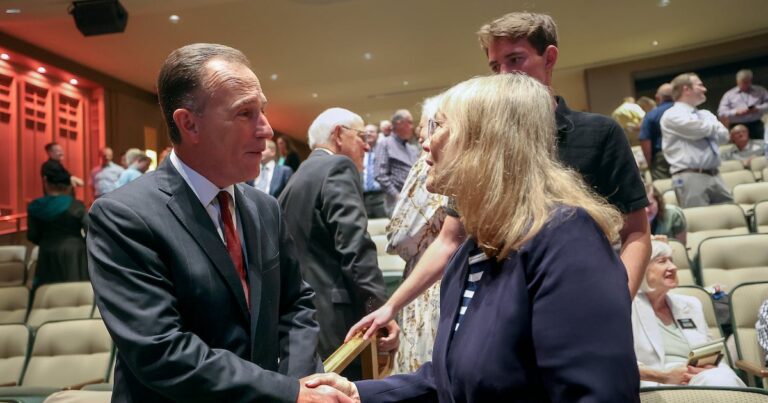September 5th, 2025, 4:17pm MDT
Most members of the Latter-day Saint Church of Jesus Christ may be familiar with the historical account of Joseph Smith reluctantly allowing his scribe, Martin Harris, to borrow 116 pages of a 116-page Mormon manuscript.
The young prophet said to him “No” by the Lord before Harris was allowed to show only to a small number of families. However, the page disappeared and never recovered.
After severe punishment from the Lord, Joseph Smith was allowed to learn valuable lessons and continue his translation of the Book of Mormon.
In his keynote speech to hold the Church History Conference on Friday, September 5th, Elder Kyle S. McKay told the story before asking questions. “Who is the central figure in this story?”
Talked to hundreds of people gathered at the Conference Center Theater and others watching online, he came up with a few characters and their roles before providing the answer – Jesus Christ.
“The Savior declared on several occasions, “I am in your midst.” By definition, “center” means the central central meaning,” said Elder McKay, 70 directorate general, who is a historian and recorder of the church and serves as executive director of the church history department.
Elder McKay cited five Bibles of Doctrine and Covenant in which the Savior uses the phrase “I am in your midst.” (See Doctrine and Covenants 29:5, 38:7, 49:27, 50:44 and 61:36.) This phrase was included in the theme of the two-day meeting.
“He’s really in the midst of this continuous recovery, and most relevant, his work,” Elder McKay said.
Christ and the Lost Page 116
Elder McKay said that the Savior’s involvement began hundreds of years before his birth, when Prophet Neiphy was maintaining a detailed record that was later summarized by Prophet Mormon.
“Christ quietly urged Mormon, the editor and editor of Nephi’s big plate, to include it at the end of this short record hundreds of years ago at the end of his waste,” he said.
After Morni, the son of Mormon, they were kept for 1,400 years after filling the plates.
“I don’t care how skilled Moroni was in making stone boxes. Those plates won’t survive unless the Lord preserves them from weather, earthquakes, animals, insects and erosion. …It was an impressive preservation stretch,” Elder McKay said.
Afterwards, the dish is buried in Joseph Smith’s family and everything the Lord has done must be considered to bring him to a place near the hill where 14-year-old Joseph Smith saw Heavenly Father and Jesus Christ.
The Savior then sent Angel Moroni to his tutor and prepared Joseph Smith before the Book of Mormon departure and the loss of 116 pages.
When translation resumed, Joseph discovered that Nephi’s small plate contained a similar explanation of what was lost by Martin Harris.
“They were written by Nephi for purposes he didn’t know, and included in Mormon for reasons he didn’t understand, but the Savior knew because he was inside all the time,” Elder McKay said. “Jesus Christ is the central figure, the protagonist of the 116 Lost Pages Saga, and he is at the center, in the midst of all events of all recovery.”
invitation
Elder McKay invited meeting attendees to “see” the Savior in Church history.
“When we are centered on Christ, we protect ourselves from the troubles that may arise when he is removed from the middle,” he said. “If he’s at the center, it doesn’t matter what mistakes or potential distractions are happening around him.”
Elder McKay warned that the Savior’s hand is in everything, but that does not mean that he caused everything.
“He never lost the manuscript to Martin Harris, but he planned it,” he said. “Note that it is due to Christ, who he did not, but is willing to save us.”
Elder McKay concluded with the Savior’s witness. He encouraged everyone to find Jesus Christ in the history of the Church and in his personal history.
“Looking back and rethinking each event in the history of the Church, just as we did the 116-page episode, may be an interesting and even important movement for each of us to re-read and rethink each event in the history of the Church. He is a central figure throughout history. “Look back at your own personal history. Can you see him in the middle of you?”
